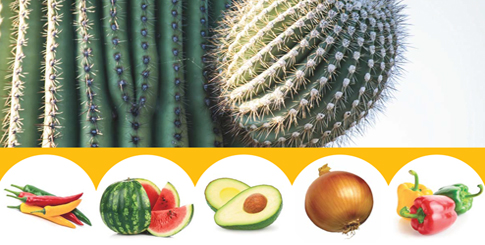“We’re offering about the same amount of eggplant and squash as last year,” Ciruli notes, with plans to bring in both hot peppers and tomatillas this month. Next month, February, will begin the company’s substantial mango deal out of Mexico.
Ciruli says the increase in Mexican greenhouse volume allows shippers to get crops to market earlier in the winter season and keep them on the market longer. As far as competing with Canada’s greenhouse produce, he admits there is some competition, but it’s more of a complementary nature.
“There are two different types of cucumbers,” elaborates Ciruli, “there’s the European cucumber, which is mostly what the Canadians grow, and the traditional cucumber, that’s grown in Mexico.” Each commodity has a market and demand that may overlap, but generally do not compete directly.
He also points to another factor in the rising demand for greenhouse-grown commodities: for some consumers, once they buy and taste greenhouse vegetables, they become accustomed to the consistent quality of ‘perfect’ produce.
“They want a green cucumber—one that’s all green, with no yellow underbelly or field blemishes,” Ciruli says. And once this happens, some consumers will no longer accept “the old-style bush cucumbers grown in the field anymore.”
Variety is the spice of life
Bill Sykes, president of The Sykes Company in Nogales, sources everything from Mexico—including grapes, various types of squash, watermelon, and other fruits and vegetables—and has seen upticks for certain commodities. The grape deal beginning in May went well; then came the cascade of vegetables.
“We’re increasing our volume on watermelon and all varieties of hardshell squash—butternut, spaghetti, kabocha,” Sykes shares. “It’s hard to say where the demand is coming from exactly, but I suspect it is a byproduct of the industry’s effort to educate consumers and increase their confidence and desire to eat healthier and include more vegetables.”
Espinoza of Produce House is on the same page as Sykes, with more plantings of hard squash such as acorn, butternut, kabocha, and spaghetti.
Much of the surging demand is attributed to the vegetable ‘noodle’ craze, with squash varieties among the more popular items sliced into thin spirals and packaged like fresh pasta. The trend continues to gain steam with foodservice suppliers selling to supermarkets and chefs serving creative dishes at restaurants across the country.
Shifting Consumer Trends
Consumer trends, as pretty much everyone in the industry has experienced, can be peculiar. In the tomato sector, Del Campo’s Ley Vela says the once-popular beefsteaks and on-the-vine varieties have stagnated a little, while Romas continue to increase in popularity.



